Best Marketing Materials: Print’s Back and It Means Business
Let’s talk about marketing materials for your small business. Believe it or not, potential customers still want printed marketing materials to hold in their hands. If you are like most small business owners, you get most customers at networking events, or direct mail campaigns. Even in an online world, people love this type of direct marketing strategy because it’s so cost-effective.
These days traditional print marketing has been put on the back burner. That’s too bad. Just because everyone is walking around with a mobile device, doesn’t mean that traditional marketing materials don’t work for small businesses. Creating custom marketing materials can attract new customers and set your business apart.
Brand recognition is crucial for success and helps businesses stand out in various industries.
In this article, you’re going to get a list of the best marketing ideas that you can use to create marketing materials for your business.
Let’s dive right in.
What are marketing materials?
Marketing materials cover a wide range of items that communicate your marketing message to customers. Effective marketing materials serve as a reminder to call your company and use your services. These items may include printed products like business cards, brochures, presentation folders, and catalogs. Signs, banners, and even billboards can be classified as marketing materials. Other promotional items, like t-shirts and coffee mugs, are other examples.
Why Marketing Materials Still Matter
Most small businesses don’t have the luxury of hiring sales people. This is where well developed and thought out marketing materials can do that job.
Content marketing includes all kinds of content, and marketing materials are content. Often, they are printed content, but that counts.
Customers want to hold and reference marketing materials about high-value purchases.
Out of sight. Out of Mind. This phrase doesn’t just apply to people, it applies to conversations and product information. Websites disappear from your screen but paper tends to stick around.You search for information or pricing and then something gets in the way and suddenly the page you were looking at is gone.
If you sell a high-priced or high-value product, you want to have printed marketing materials. Here’s why.
Printed marketing materials tend to float around. Not only that, but if you’re selling a “high involvement” product — something that’s expensive or important such as a furnace, or a high-priced service, your customer will want to have that information close at hand.
Printed marketing materials get passed around.
One of the great things about marketing collateral is that they have a long “shelf-life” – and get passed around from one prospect to another.
Think of them as additional advertising or support for folks who refer you to their friends and family.
If you use direct marketing to sell your product or service, you want to make sure that all of your best and ideal customers have information about your company in their hands.
Marketing collateral supports and builds your brand.
Well-designed and well-written collateral will make your brand stand out from the competition and they will make your brand widely visible. Here are 9 marketing material ideas you can use at networking events.
The key to success is making sure that your brand is consistent across all of your business materials. Here are just a few tips:
-
Make sure that your logo and logo colors are consistent across your business cards, brochures, letterhead, envelopes, etc.
-
Check your fonts! Your business brand should have an official font for the logo, for letterhead and across all of your printed materials. Be sure to have a consistent font for headlines, for copy and for captions under any images.
-
Use consistent imagery. If your brand is using photos, then keep using photos across all of your marketing materials. Don’t mix and match photos with illustrations.
-
Ensure all visual assets stay on brand by using consistent colors, fonts, and logos to align with your brand’s identity and visual strategy.
-
Check the addresses on all of your marketing collateral — if you’ve moved or changed, you’ll want to re-print them.
-
Re-read and review all of your materials to make sure that your products and services are still current.
Try These Quick Start Tips to Develop Your Marketing Materials
Be consistent with your brand! Make sure that you’re using consistent colors, fonts and images.
There are so many great resources for putting all of these items together.
TailorBrands is a DIY Marketing tool that you can use to create your basic branded materials.
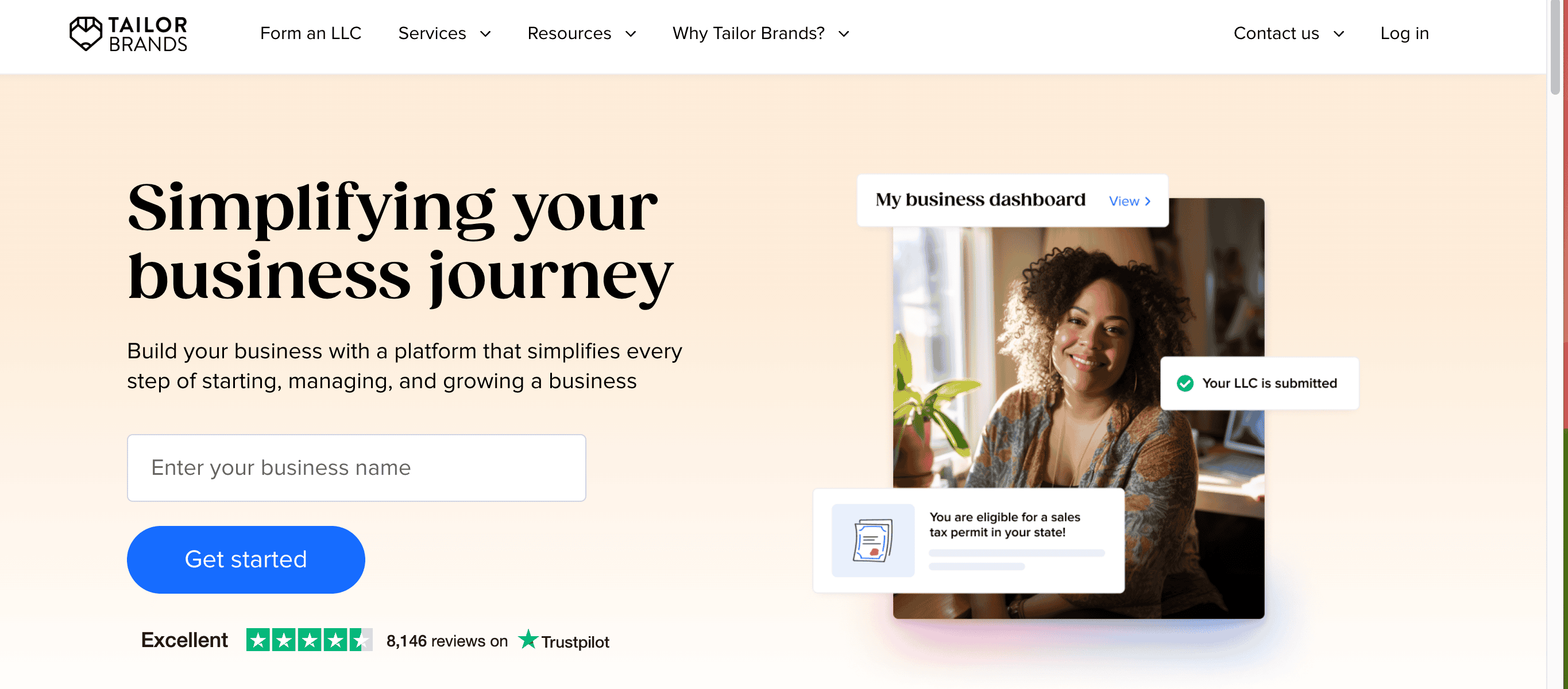
99designs is another option of you’d like to work with a professional designer.
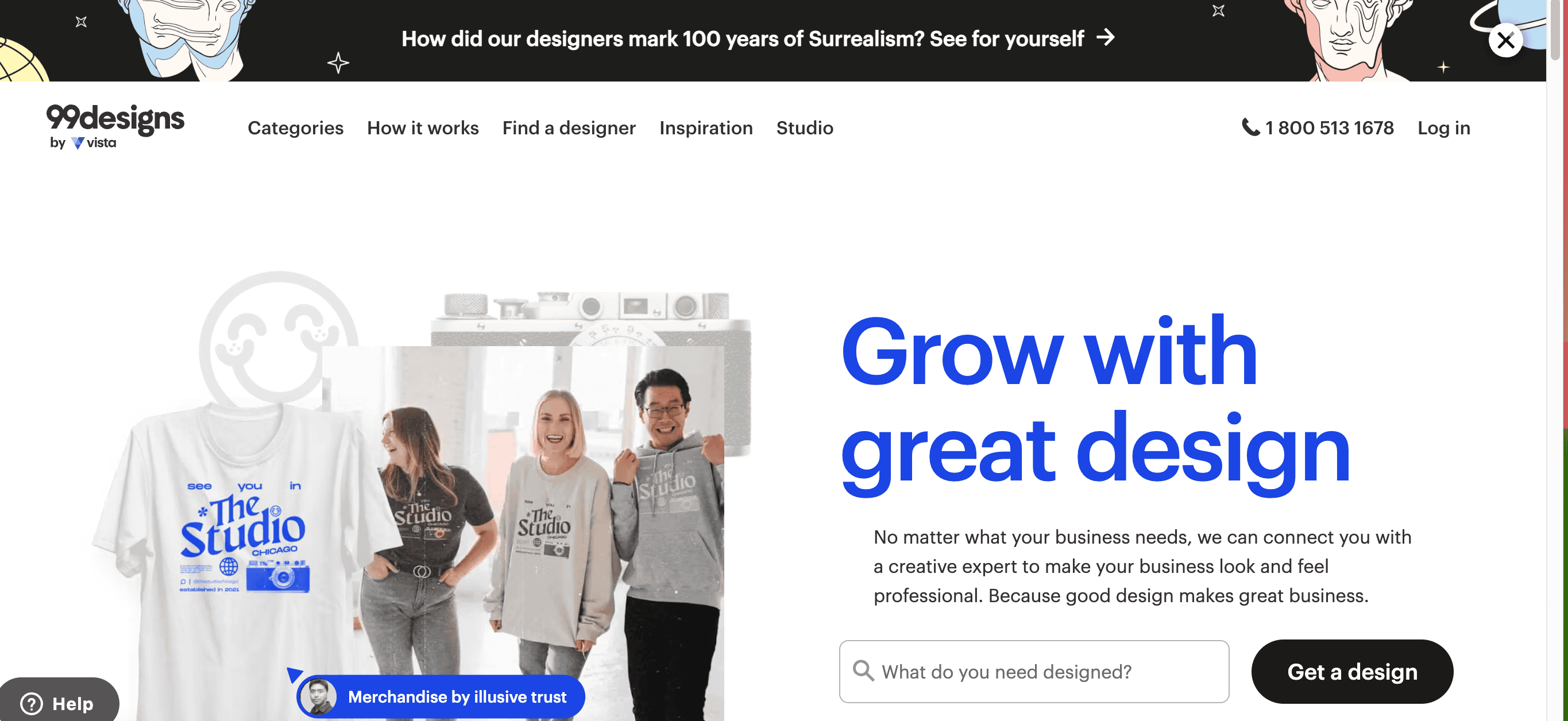
No matter what resource you decide to use, get a “style guide” or “brand book” that you can reference.
Here’s an image of the DIYMarketers Style Guide so that you can see how simple it is.

This is the DIYMarketers Style Guide. I share this with designers and team members to make sure all of our materials have a consistent look and fee.
How to Use Your Marketing Collateral
And now for the good stuff.
Here’s my list of types of marketing materials that are ideal for small businesses. I’ve grouped these materials into five categories. I’ve also placed these categories in order of the marketing and buyer’s journey. This goes a long way toward helping you understand exactly how you can use each type of marketing material.
Tips on How to Use Small Business Brand Building Marketing Materials
Every small business has these brand basics but most don’t leverage them for maximum branding exposure. Unfortunately, most of these materials are taken for granted and often relegated to boxes in the back of the supply closet. Here are a few creative ways to use these staples of materials.
Examples of Creative Printed Marketing Materials
Here is a list of general business marketing suppliers and printed materials that you should always keep updating. I don’t recommend that you spend a ton on these.
1. Business Cards
If there’s anything that digital marketing has taught is, it’s how important user experience is. In the same way that we treated websites like digital brochures, we’ve done the reverse and are starting to treat business cards (especially printed business cards) like printed websites. And that means putting the recipient at the center of the experience and making them a useful and active piece of our marketing.
-
Add your logo and tagline to your business cards
-
Be sure to include an email address with your business domain. name@yourcompany.com
-
Use that valuable back-of the-business card real estate as an appointment card, price list, or print something unique and memorable about your business.
-
Include extra business cards in every correspondence so that customers can refer you.
-
Use a version of your business card as a sticker for envelopes.
-
Add your social media URLs to the card (not just the logos).
-
Put a short survey on the back of your business card
-
Keep a list of referral partners and give them enough cards.
-
Include in invoices and correspondence and bags.
-
Add your price list to the back of the card.
-
Put helpful info on the back. You can use a QR code to send them to a sales page.
-
Add a coupon on the back.
-
Place a promotional offer on the back of the card i.e. free consultation.
-
Leave your card in relevant businesses i.e. banks, libraries.
2. Letterhead
Email has killed the letterhead, unless you’re an attorney. But this can still be a valuable marketing tool. You know, letterhead used to be formal, but it doesn’t have to be. Again, think of your customer and how you can improve their experience with you. Have a little fun with it.
-
Is there a phrase or tag line that you always use in your business? Slap it on the letterhead and the envelope.
-
Send personal letters/notes to customers on letterhead
-
Create a letterhead design that makes your sales presentations pop.
-
Use letterhead for printing invoices.
-
Create notecards as letterhead for more information communication
-
Send direct marketing mailings on letterhead and insert brochures, coupons, etc.
3. Envelopes
Just like letterhead, branded envelopes don’t seem to be a thing anymore. And I say WHY NOT? When others zig, you zag. Bring back letterheads and envelopes but use them to stand out in the real world. Write notes and letters to your customers — using your HANDS and a pen. I know, it’s old school, but you will absolutely stand out.
-
Match your envelopes with your letterhead.
-
Add unusual script or text on your envelopes to make them stand out.
-
Consider larger branded envelopes for presentations.
4. Brochures
Brochures are back and better than before. You can have all kinds of brochures; company brochures which give a broad description of your company or product brochures which get into the nitty gritty details about a specific product or service.
-
Match brochures with your brand design
-
Have a basic brochure and create additional brochures for different groups of customers or for different products
-
Include call-to-action information so prospects can order: email, order landing page, phone, address – across the bottom.
-
Include any instructions on how to buy or place an order.
-
When you update brochures, send them out to customers along with a friendly letter on your letterhead. Your customers will love it.
-
Create a block of text that contains contact info for questions.
-
Put clear offers at different price points to entice new customers.
-
Be sure to add a copyright to designate “rights reserved”
-
Use brochures to tell your brand’s story and effectively communicate with your target audience.
-
Include any product specifications and details or QR codes that lead to important product information.
5. Outdoor Signs
Don’t diss on outdoor signs. Outdoor signs are a marketing material that can generate as much as 150% additional foot traffic to your store. While there isn’t a lot of information about the specific content that generates the most foot traffic, I’d say that signs that feature special offers, discounts, and customer benefits would do the best.
-
If you have an outdoor sign, make sure that it’s in good shape; lights working, letters and writing visible from a distance.
-
Keep outdoor signs simple and eye-catching
-
Stay away from ALL CAPS – use a mix of fonts in different styles or sizes.
-
Define the purpose for your outdoor signs and stick to it.
-
Be specific about your offers- what, how much, until when.
-
Add point-of-purchase signs to drive customers to featured products.
-
Use window decals to clearly display hours of operation.
-
Add humorous or colorful outdoor tent signs featuring specials.
Sales Presentation Materials: Here are some tips
The next phase of the sales and marketing process is to educate your prospects. This set of materials is especially handy for high-involvement purchases (such as industrial machinery or high-end home purchases).
While I’m featuring printed collateral here, all of these materials are easily adapted to your digital marketing as well.
Treat these as content marketing
That means your primary focus is the customer and what information they need to make a good decision (and choose YOU over the competition).
6. Case Studies or Use Cases
If you’re in the technical, manufacturing, or service space, case studies are a terrific marketing material to offer your customers and prospects.
Typically, case studies are BORING. Why? Because they are often about someone else, and not about the prospect. Instead, try creating “use cases” these are more focused on the application of your product or service and will grab your prospects attention because they will see more of themselves in the content.
-
Choose examples from ideal customers that feature your most profitable. products and services.
-
Write case studies with a focus on the problem being solved and how you solved the problem.
-
Keep case studies short and to the point.
-
Use your customer’s words instead of industry jargon
-
Add visuals and graphics
-
Place case studies on your website.
-
Link to case studies from your content.
-
Add clearly visible or “slide in / pop up” calls-to-action.
-
Put case studies on your home page – you can change them regularly.
-
Include a feedback or chat box.
-
Pull testimonial quotes from case studies and feature them on your home page.
-
Create articles, blog posts, infographics from case studies and promote on social media.
-
Create videos from your case studies.
-
Post your case studies on social media.
-
Use case studies in your email marketing.
7. Sales Sheets / Product Sheets
Sales or product sheets tend to be more popular in manufacturing, but when you think about it you see them everywhere in the digital marketing space — like Amazon product pages:
Here is a typical digital product sheet from Amazon.com in the form of a comparison table.
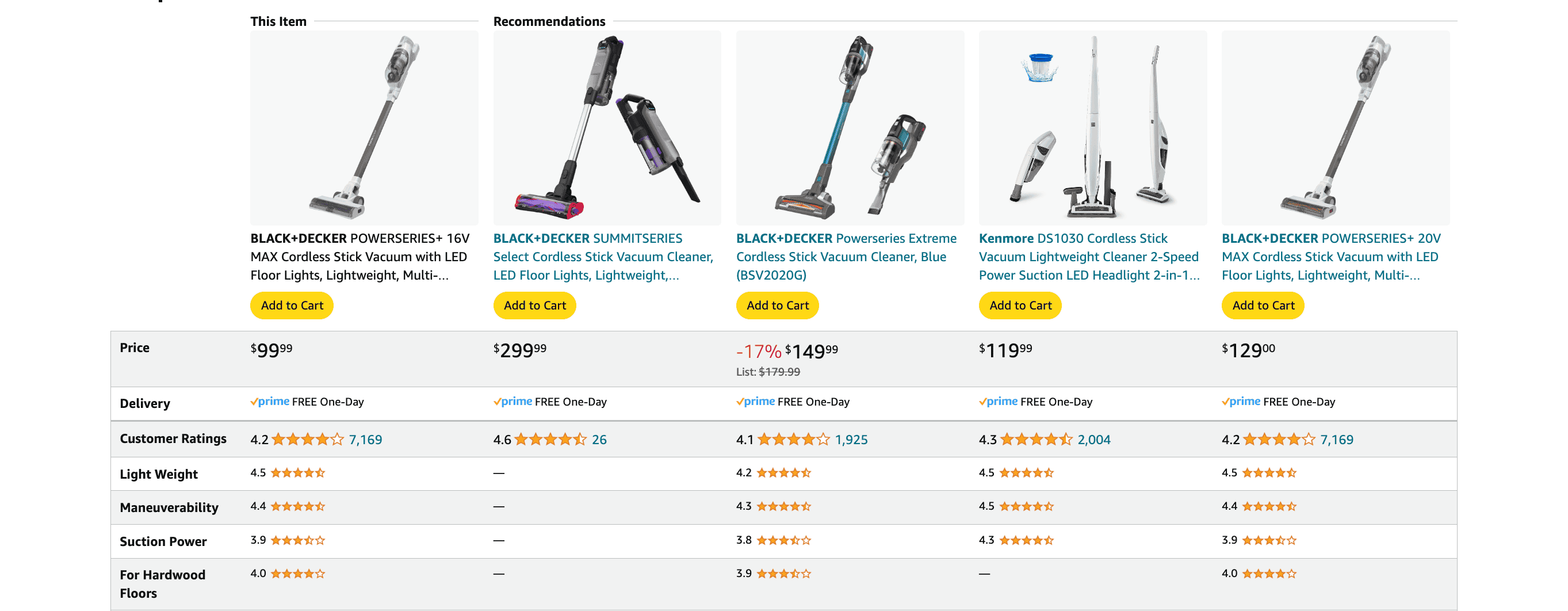
The real value for the customer here is that they get into the nitty gritty of what the product or service is, and how it compares to other alternatives.
-
Use your branding style sheets and fonts.
-
Make fonts and colors are easy to read.
-
Feature your USP for each product or service.
-
Focus on your marketing message in product descriptions.
-
Include client and customer testimonials.
-
Explain or show product applications.
-
Create “Offer Tables” that spell out what’s included at different levels.
-
Include pricing information or links to pricing information.
-
Spell out what level of support is offered for each product or service.
-
Include links to product order pages.
8. Presentation Folders
Anyone who has been in sales will tell you that presentation folders are a wonderful way to lead prospects through a sale — or help existing customers purchase additional products or services.
The purpose of a presentation folder is to make it easy for the “recommender” in the sales situation to take your material and share it with the C-level executive who is the decision maker. So this specific marketing material should be focused on helping them see the value and ROI of purchasing from you.
-
Create a useful or interesting folder – perhaps as an envelope.
-
Make sure folders are big enough to fit all of your collateral.
-
Use your folder as a selling tool by Including an infographic that features a chart or table about your products and their applications.
-
Include contact information, calls to action and links to specific landing pages where they are easily found.
9. Testimonials
Testimonials still work! Just remember that yesterday’s testimonials won’t work as well. When you’re creating testimonials for today’s customers, make sure that they are focused on storytelling: Where were they before, and after using your product or service? What did they think they were going to get and what they got? These kinds of stories help connect the testimonial to the reader and their circumstance.
-
Use your company name and brand name in every testimonial.
-
Select those testimonials that speak directly to your USP.
-
Match testimonials to specific products or services.
-
Feature relevant testimonials on website product pages.
-
Create “pop up” testimonials along with a call-to-action.
-
Be sure to collect testimonials that speak to your outstanding customer service.
-
Feature testimonials on your Facebook Pages.
-
Take pictures of written testimonials and upload them as images on your “Google My Business” page.
-
Encourage online reviews from customers.
10. Slide Deck
To create a lasting impression, it’s essential to have a custom-branded slide template that aligns with your brand identity. This consistency reinforces your marketing message and helps your audience recognize and remember your brand. Consider developing a signature talk that showcases your expertise and addresses the typical problems your target audience faces. This talk can be shared on LinkedIn to reach a wider professional network and generate interest in your offerings. Remember to include a clear call-to-action in your presentation, encouraging the audience to download the slides and offering a free resource related to the topic. Additionally, prominently feature an irresistible offer for sharing the presentation, enticing your audience to spread the word and expand your reach.
-
Have a custom-branded slide template for everyone to use.
-
Create a branded signature talk to post on LinkedIn that features your marketing message and typical problems solved.
-
Include a basic call-to-action for the audience to download the presentation and a free resource.
-
Prominently feature an irresistible offer for sharing.
11. Explainer Video
Transform your slide deck into a compelling 90-second explainer video. This visually engaging format not only captures attention but also effectively communicates your key messages. To maximize exposure, include a link to your explainer video on your business cards and brochures. This way, potential customers can easily access more information about your products or services. In sales presentations, incorporate your video to enhance the delivery of your message and provide a dynamic visual experience. Including a link to a sales page in the video description allows interested viewers to seamlessly transition to the next step of the buying process. To expand your online presence, share your explainer video on social media platforms, leveraging their reach and engagement potential. This enables you to connect with a broader audience and create opportunities for interaction and conversion.
-
Convert your slide deck into a 90-sec explainer video.
-
Include a link to your video on your business cards and brochures.
-
Incorporate your video into sales presentations.
-
Include a link to a video.
-
Include a link to a sales page where customers can place orders.
-
Share your explainer video on social.
Conversion Focused Materials
Your marketing materials are like a 24/7 sales rep who is there to speak on behalf of your business. So make sure that you’re adding all the information your customer will need to contact you and buy from you.
When creating your flyers, postcards and menus keep customer conversion at the front of your mind. Put yourself in your customer’s shoes. Then, imagine your customer with one of these objects in their hand.
-
What problem is your customer solving?
-
How have they tried to solve the problem?
-
What is your unique way of solving that problem?
-
What’s the payoff or benefit to your customer?
-
What action do you want them to take?
12. Flyers
I still love flyers! Whether you’re a local business such as a landscaper or house cleaner or even a professional service, flyers are great at addressing the Interest and Decision elements of the AIDA (Awareness, Interest, Decision, Action) model.
-
Create a branded flyer template.
-
Print professionally on glossy heavy paper.
-
Create flyers for each customer segment.
-
Use flyers for special offers.
-
Create informational flyers for specific products or services.
-
Add customer testimonials to flyers.
-
Add coupons or free offers to flyers to entice foot traffic.
-
Staple customer receipts to flyers and place in a bag.
-
Mail new flyers to customers inside invoices or other communication.
-
Create a PDF of your flyer and send links to customers via email.
-
Distribute your flyers to complementary local businesses.
-
Mail to customers.
-
Visit neighborhoods to deliver or leave at door.
-
Post online on Instagram or Pinterest.
-
Use door hangers as part of a marketing strategy to boost brand awareness and promote products and services to a targeted audience.
13. Postcards
Postcards get a bad rap for one simple reason — the copy. Too often, postcards are all about the company and the offer at hand. Now look, postcards (or any direct mail materials) are expensive. You’re basically spending money with no guarantee of conversion, and no easy ways to know and understand what resonates with the audience.
Check out this postcard example and what they are doing right:
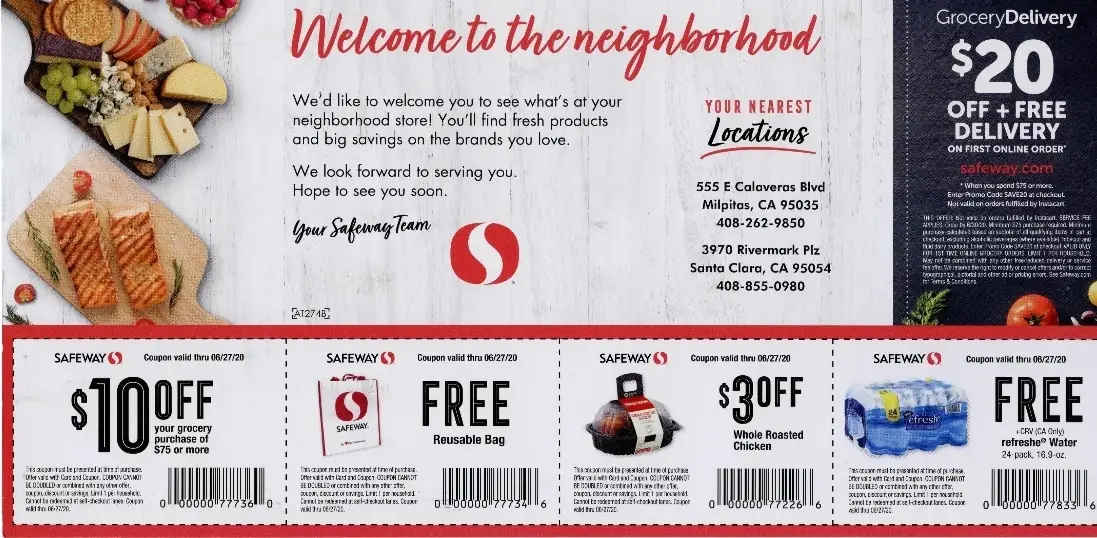
Targeting and connecting with a specific customer: I love that they are speaking to a specific audience (new residents) with a specific need (getting groceries and food after a move).
Special and relevant offers: Their offers are perfectly targeted to what new residents need; groceries, delivery, ready to eat food, water, and delivery.
So many great things about this example.
-
Create a branded postcard design that complements your brochures, cards, etc.
-
Use postcards as invitations to special customer or neighborhood events.
-
Feature a lead magnet such as an ebook or checklist and invite opt-ins.
-
Feature a new product or service and take early orders.
-
Use testimonials on your postcard.
-
Get new customers using a targeted mailing list or USPS EveryDoor Direct Mail (EDDM).
-
Distribute postcards to local businesses.
-
Add a story about your business.
-
Make them EASY to read. Use larger fonts.
-
Avoid overlays or print screens.
-
Stay consistent with your brand.
-
Create PDF or printable menus to download. Invest in great descriptive menu copy.
-
Post your menu on Facebook, Instagram and Pinterest.
-
Post pictures of your menu items on social.
-
Encourage customers to post their orders on social – have them add a hashtag or mention you for a discount.
Customer Support Materials
A lot of businesses either skip or skimp on these elements. But adding at least one of these to your customer support materials can improve customer loyalty and drive referrals.
15. Thank You Cards
I’m advocating for a personal touch. I get mailed out printed thank you notes from my local car repair provider and it makes me nuts — it’s not personal and it costs money. Every time I get one of these I think “Save your money and lower your prices” or “Pay your people more instead of spending money on this lame card that I’m throwing away”
This could be so much better if they included an offer; a discount, a coupon, a free service next time.
-
Invest in professionally printed and branded thank you cards.
-
Add a handwritten note.
-
Include a Thank-You gift, product sample or gift certificate.
-
Send cards after – a , a problem you solved, a big order.
16. Loyalty cards
Some folks are still using punch cards — I don’t know about you, but I’m always losing them. I’d much rather get a coupon or a discount. In other words, don’t make me think about it.
-
Most loyalty is online, stand out with a “hard” loyalty card or gift certificate.
-
Print high-end, gift certificates
-
Send out $25 – $50 gift certificates to existing customers. This encourages them to come back and bring someone.
17. Posters
Posters are a great way to put specific messages and offers in front of your customers. Local, in-person businesses often take advantage of posters to feature specials, services, and other products that aren’t obvious to the customer. Another great way to use posters is to provide instructions, and a way for customers to connect with you digitally.
-
Create posters about how your business makes your customers “feel”.
-
State your message in as few words as possible (no more than 5).
-
Use posters as a decorative feature in your offices.
-
Highlight your company values and mission.
-
Feature employees.
-
Feature customers and add a testimonial.
-
Craft an irresistible offer and make a poster out of it. (Think value-meal).
-
Choose the right location – make it relevant.
-
Create posters focused on how you serve customers.
-
Put your company info and relevant URLs at the bottom of the poster. Make it visible and easy to find.
-
Create artistic posters and use them as promotional awareness builders.
-
Use posters to build brand recognition and set your business apart from the competition.
18. Catalogs
Printed catalogs have gone through a massive evolution over the last few decades. They used to be nothing more than product images. But today, some of the best catalogs tend to engage the customer via stories — like a magazine. Patagonia was one of the first examples. Another example I saw recently was Duluth Trading where they featured a small boat building business and their team. I learned about boat building and bought some socks and underwear for the men in my life.
-
Develop a concept for your catalog.
-
Match your brand.
-
Create a mini-featured product catalog or flyer.
-
Make sure your catalog copy has a voice and point of view.
-
Make it fun to read.
-
Create a theme for the year/season.
-
Feature customer in your images.
-
Feature your target or ideal customer.
-
Include customer reviews and testimonials next to featured products.
-
Dedicate a section to customer service and support.
-
Print all relevant customer service contact information, web sites, emails, phone numbers.
-
Mail your catalog to existing customers.
-
Send catalogs to your prospect lists.
-
Mail your mini catalog to prospects (buy a targeted mailing list).
Examples of Promotional Marketing Materials
Promotional materials — aren’t just for trade shows! Think of promotional marketing materials as reminders and prompts for prospects to become customers.
Get more return on your investment from trade show promotional products by incorporating them throughout your whole business.
19. T-Shirts
Always fun — especially if the graphics and text you have on your t-shirts support your brand. Yeah, we all have too many t-shirts, but a great t-shirt can take your brand and marketing message a long way.
Got a team (virtual or on-site) send them branded t-shirts and hats. My husband consistently gets a few high quality shirts each year that he wears to work like a uniform.
-
Optimize your log or create an icon. of your logo that is easily embroidered or printed on clothing.
-
Select approved clothing items that can have a logo, tagline or other branded language
-
Trip the reciprocity trigger with branded clothing gifts to prospects.
-
Print a special offer on branded clothing and have everyone wear it for a period of time.Encourage employees to wear branded clothing at work and in their personal life.
20. Promotional Products: pens, mugs, keychains, etc.
Standard promotional swag like pens, mugs and keychains get a bad rap. These are always a good idea (especially high-quality, and high-performance pens) that everyone loves.
-
Spread the visibility of your brand to other useful items – beyond pens and mugs i.e. battery chargers, notebooks, etc.
-
Have a collection of branded items when customers visit for them to take home.
-
Create a branded basket as a customer or prospect gift.
-
Include a phone number or extension and contact info where people can call to get help and support.
-
Give out branded promotional products throughout the community – church, schools (who always need materials), sports teams, etc.
-
Maintain brand consistency in online ads to ensure cohesive marketing materials that engage the audience and move them towards action.
You’ll Need a Marketing Collateral Distribution Tools to Manage Everything
Honestly, I’ve never heard of the phrase “marketing collateral distribution” but it’s a thing, and whether you’re a solopreneur or you have a team, you’re going to need a way to keep track of your print marketing materials.
I’ve found two marketing collateral tools to keep track of your print marketing materials so that you can keep your brand consistent and know when it’s time to update.
Use this Excel Template
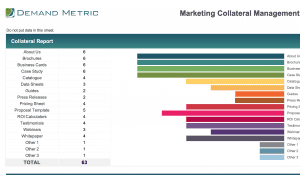
Demand Metric has this wonderful excel template that will help you keep track of when you should update your print marketing materials. It’s free if you register.
Ballpoint Marketing for Handwritten Printed Marketing Materials
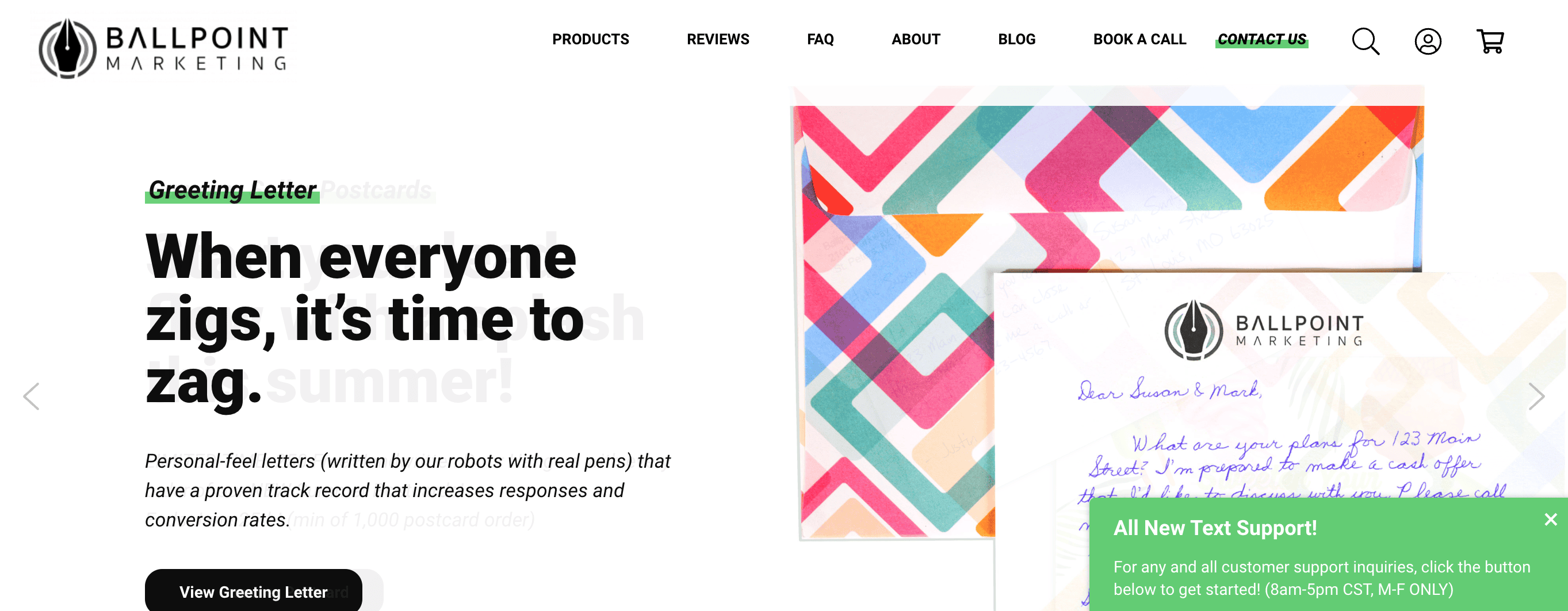
Personalization is a powerful element in your marketing strategy. Luckily, there are affordable ways to add personalization to your printed materials whether you have an offline or online business.
I recently discovered Ballpoint Marketing! I like to think of them as a direct marketing company because they offer high-end, low-cost ways to get your personal message and offer in front of your customers. Here are a few examples I want to share with you
Personal Letters
If you’re in the professional services business; legal, financial, medical, etc., these are great ways to create thank you cards, announcements, or send offers in a very personal way.
Handwrytten
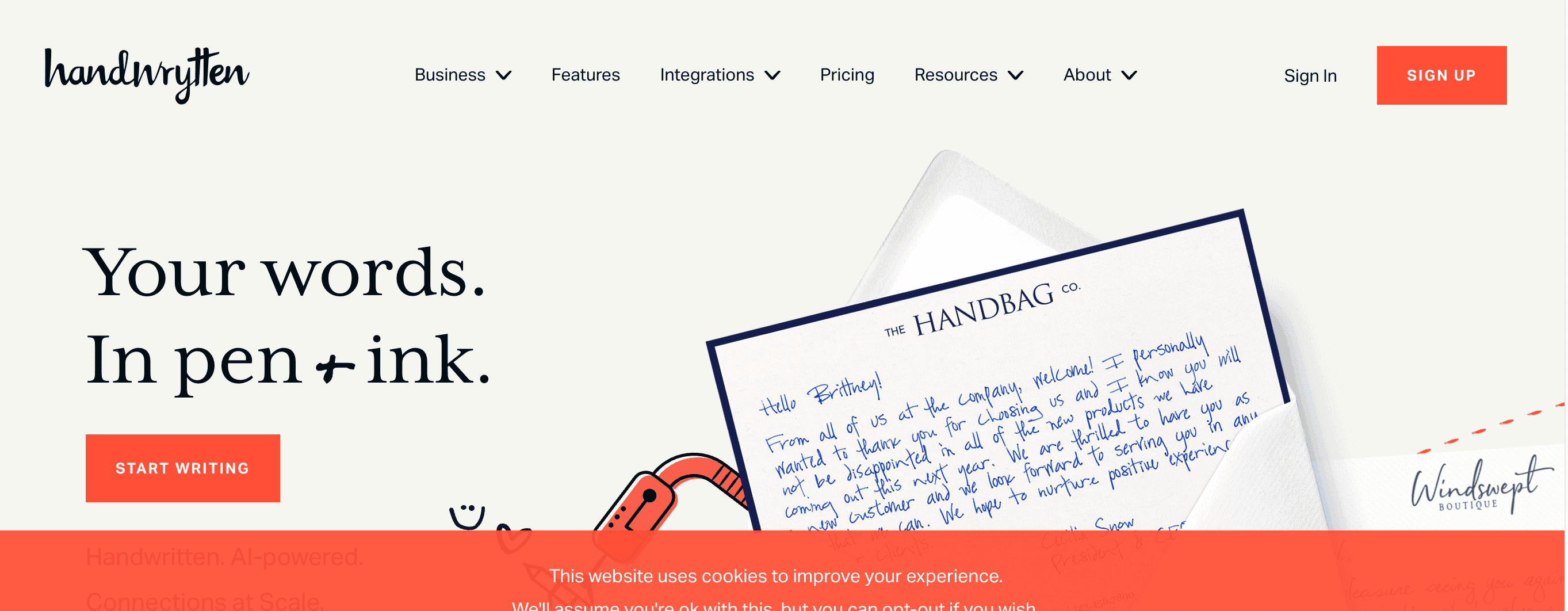
If you want to send individual personalized mailings, you MUST check out Handwrytten. This is a product I’ve used to send personalized thank you notes. If you hate your handwriting, but want to send personalized notes, this is a terrific resource
OK, so you’re inspired and ready to get going!
Low budget marketing strategies for CEOs with no marketing department. Join DIYMarketers.com for free marketing tips.
Source: https://diymarketers.com/19-best-marketing-materials/
Anyone can join.
Anyone can contribute.
Anyone can become informed about their world.
"United We Stand" Click Here To Create Your Personal Citizen Journalist Account Today, Be Sure To Invite Your Friends.
Lion’s Mane Mushroom Nootropic
Mushrooms are having a moment. One fabulous fungus in particular, lion’s mane, may help improve memory, depression and anxiety symptoms. They are also an excellent source of nutrients that show promise as a therapy for dementia, and other neurodegenerative diseases. If you’re living with anxiety or depression, you may be curious about all the therapy options out there — including the natural ones.Our Lion’s Mane WHOLE MIND Nootropic Blend has been formulated to utilize the potency of Lion’s mane but also include the benefits of four other Highly Beneficial Mushrooms. Synergistically, they work together to Build your health through improving cognitive function and immunity regardless of your age. Our Nootropic not only improves your Cognitive Function and Activates your Immune System, But it benefits growth of Essential Gut Flora, further enhancing your Vitality.
Our Formula includes: Lion’s Mane Mushrooms which Increase Brain Power through nerve growth, lessen anxiety, reduce depression, and improve concentration. Its an excellent adaptogen, promotes sleep and improves immunity.
Shiitake Mushrooms which Fight cancer cells and infectious disease, boost the immune system, promotes brain function, and serves as a source of B vitamins.
Maitake Mushrooms which regulate blood sugar levels of diabetics, reduce hypertension and boosts the immune system.
Reishi Mushrooms which Fight inflammation, liver disease, fatigue, tumor growth and cancer. They Improve skin disorders and soothes digestive problems, stomach ulcers and leaky gut syndrome.
Chaga Mushrooms which have anti-aging effects, boost immune function, improve stamina and athletic performance, even act as a natural aphrodisiac, fighting diabetes and improving liver function.
Try Our Lion’s Mane WHOLE MIND Nootropic Blend 60 Capsules Today. Be 100% Satisfied or Receive a Full Money Back Guarantee. Order Yours Today by Following This Link.






